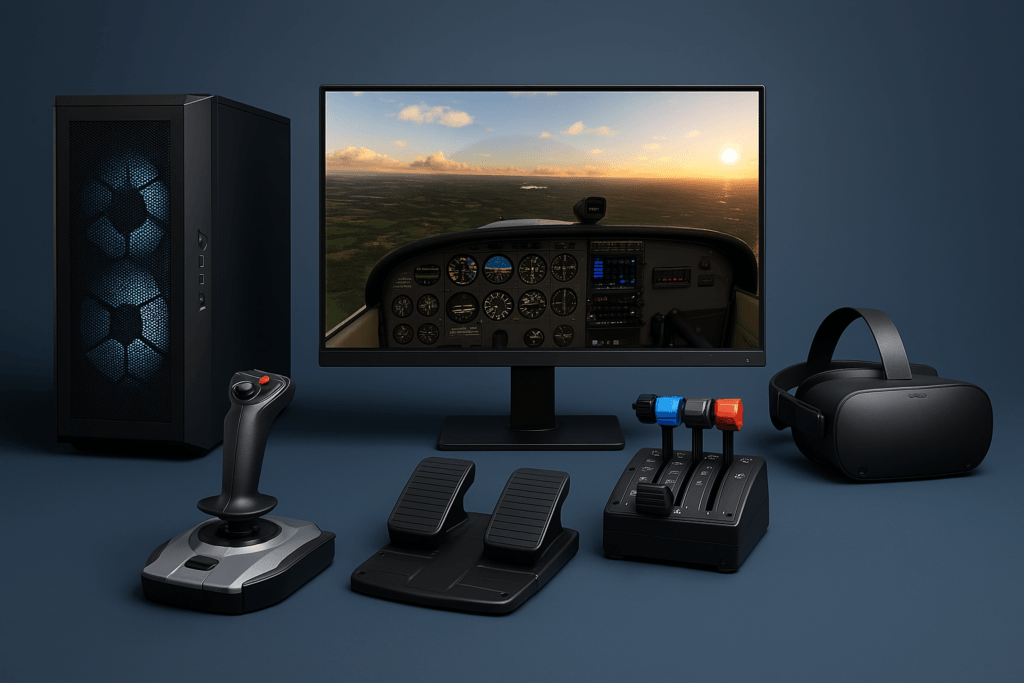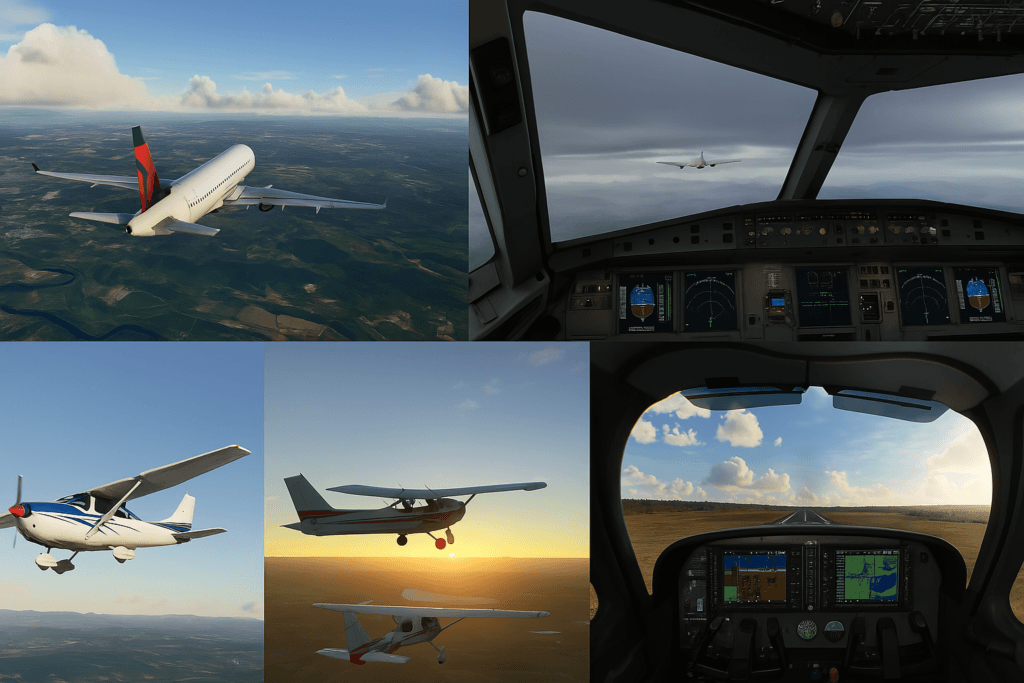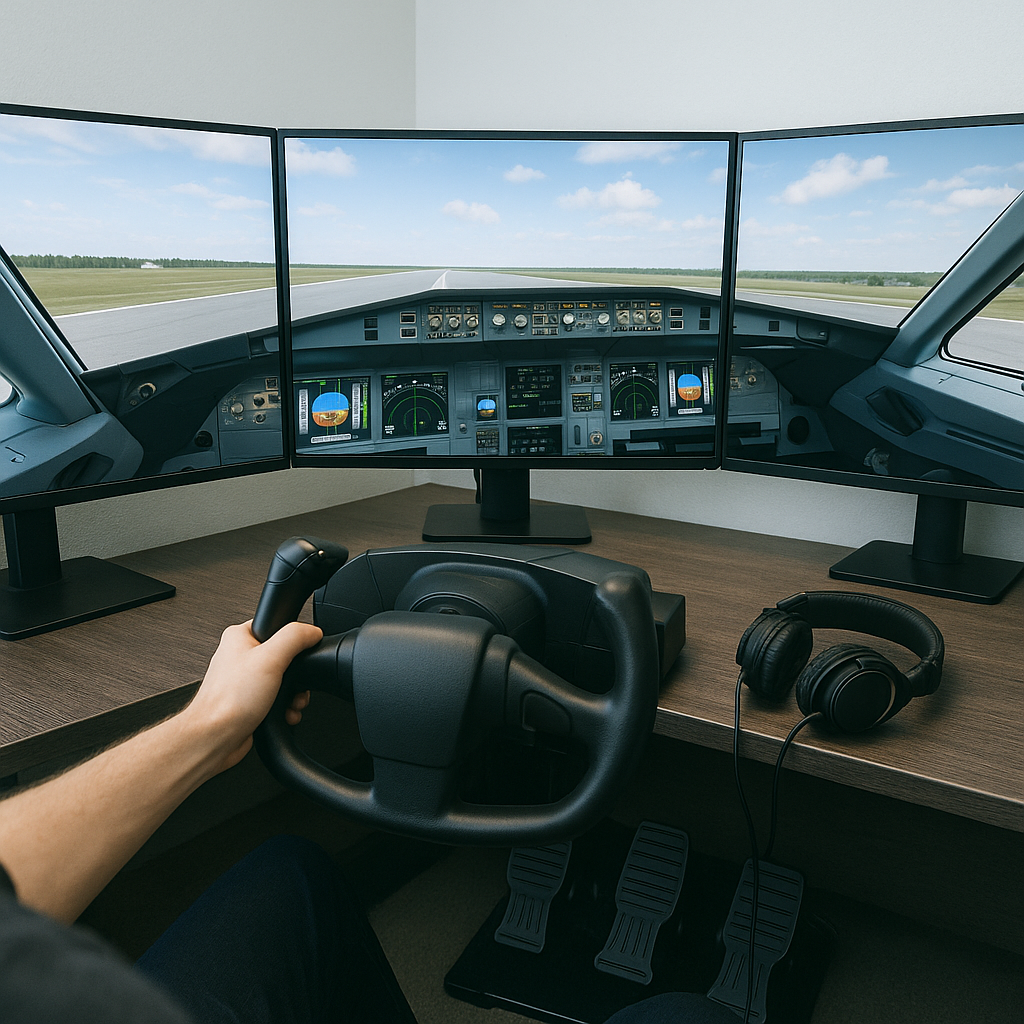Last updated on May 9th, 2025 at 10:32 am

Getting started with flight simulators is a great way to explore aviation without ever leaving home. If you’re new to the world of virtual flying, it’s easy to feel overwhelmed by all the options out there. In this guide, we’ll break things down simply—what flight simulators are, why people love them, and which ones are best for beginners. By the end, you’ll have a solid idea of where to start and what to look for as you begin your journey into virtual aviation. 👉 To get a solid foundation first, check out our Getting Started With Flight Simulation Guide —it walks you through everything step by step.
Overview of Aviation and Flight Simulators
Aviation has come a long way since the Wright brothers first took to the skies in 1903. Today, thanks to modern technology, you can experience the excitement and challenges of flying right from your own computer. Flight simulators have become incredibly realistic, blending real-world physics with detailed visuals to recreate the feel of piloting an aircraft.
Originally used for military training, simulators have evolved into advanced programs that feature dynamic weather, realistic air traffic control, and fully interactive cockpits. They’re not just for professional training anymore—they’re great for anyone with a passion for aviation who wants to experience flight in a safe, virtual environment.
Why Use a Flight Simulator?
Flight simulators are valuable tools for learning the basics of flight, including how aircraft respond to controls, how navigation works, and how to handle different flying conditions. Guided tutorials and training missions can help new users build confidence step by step.
But they’re also a lot of fun. Whether you’re curious about aviation or thinking about flying lessons in the future, flight simulators offer a hands-on way to explore flying and develop useful skills at your own pace.
Getting Started: Essential Concepts and Equipment

Before jumping into virtual skies, it’s important to understand a few basic concepts and check that your equipment meets the necessary requirements. While system specifications might seem like a technical detail, they are crucial for running a smooth simulation. Many programs require a fast processor, sufficient memory, and sometimes a dedicated graphics card – Microsoft Flight Simulator’s official requirements are a good benchmark to start with.
Beginners should look for simulators that are straightforward and offer clear, guided instructions.👉 For a breakdown of the most useful beginner tools, see our Essential Software and Tools for Novice Pilot Guide. Look out for adjustable difficulty settings; starting with simpler controls can help you get comfortable before moving to more realistic experiences. Here are some common terms you might encounter:
- System Requirements: The technical specifications needed to run the simulator, including compatible operating systems like Windows 10 or 11, processor speed, RAM, and storage space.
- Virtual Reality (VR) Compatibility: Some programs support VR headsets for a more immersive experience, although this usually requires additional hardware.
- Realistic Weather: Many simulators include dynamic weather features. Expect to adjust your flight path based on changing conditions like wind and rain.
- Multiple Aircraft Options: A variety of available aircraft lets you experiment with everything from small private planes to large commercial jets.
Having a handle on these concepts can help you choose a simulator that is not only entertaining but also educational.
Suggested Beginner Setup: A Simple Way to Get Started
If you’re just getting into flight simulation, a beginner-friendly setup can make a big difference. One option to consider is putting together a simple rig that includes the essentials — like a joystick or yoke, throttle controls, and rudder pedals.
For example, the Logitech G Flight Yoke System is a popular choice among beginners for its realistic feel and plug-and-play compatibility. If you’re on a tighter budget or flying on Xbox, the Thrustmaster T.Flight HOTAS One is also a solid entry-level option.
This kind of setup gives you a hands-on flying experience and helps you get comfortable with aircraft controls early on. It also makes the transition smoother if you ever decide to move from simulation into real-world flight training.
You don’t need anything fancy to start. The goal is to create a solid foundation, and from there, you can upgrade as your skills (and interest) grow. For a complete gear overview, Sporty’s Flight Simulator Guide is a great resource to explore.
Top 5 Beginner-Friendly Flight Simulators

Now let’s get into the details of the top flight simulator options designed with beginners in mind. Each of these offers a unique mix of features and experiences to meet different needs:
Microsoft Flight Simulator 2024
Microsoft Flight Simulator 2024 stands out as a great all-around option. Known for its vast and detailed design, it delivers a realistic sky-high experience. With dynamic weather systems, a large selection of aircraft, and VR support, it pulls you into a strikingly real flying environment.
The software does demand high-end hardware, needing Windows 10 or 11, a recent Intel or AMD processor, a generous amount of RAM, and a dedicated graphics card. One of its limitations is its heavy reliance on cloud streaming, making a steady internet connection very important. Need help setting up your PC or hardware for Microsoft Flight Simulator? This setup guide walks you through it step-by-step.
X-Plane 12
X-Plane 12 is famous for its realism. It covers many airports around the world and simulates air traffic control in a way that few others do. This focus on accurate flight dynamics ensures a very authentic experience, although it does come with a steeper learning curve and higher hardware requirements.
While there might be occasional compatibility hiccups with certain setups, X-Plane 12 is well-suited for those serious about understanding intricate flight mechanics.
Aerofly FS 2
Aerofly FS 2 is an excellent choice if your system isn’t the most powerful. It offers high-quality graphics and smooth performance on less demanding hardware setups. Although its scenery options and air traffic details are not as broad, it remains an attractive option for users prioritizing performance and vivid visuals.
Infinite Flight
Infinite Flight delivers a strong mobile experience, letting you take your passion for aviation on the go. It comes with an all-in-one navigation database and a community ready to help newcomers get started.
Even though its simulation depth might seem overwhelming at first, the many tutorials and an intuitive control interface provide a gentle introduction. Its portability means you can keep flying wherever you are, a feature that many users find very appealing.
FlyInside
Designed specifically for virtual reality, FlyInside offers a highly customizable and immersive experience that places you right in the cockpit. With VR support, you can truly feel like you are flying an aircraft.
The primary drawback is that it comes with a limited selection of aircraft and maps. However, if you’re focused on a virtual reality experience, FlyInside is a standout option that lets you enjoy an immersive simulation.
Common Challenges and Things to Consider
When beginning your journey into flight simulation, a few challenges may arise. Being aware of these beforehand can help make your experience smoother and more enjoyable. Some of the common issues include:
- Hardware Requirement: Many simulators require high performance from your PC. It’s very important to confirm that your system meets the recommended specifications to avoid unnecessary frustration.
- Internet Dependency: Some software, like Microsoft Flight Simulator 2024, depends on constant cloud streaming, so a stable internet connection is crucial.
- Realistic Weather and Controls: While realistic features add authenticity, they can also raise the difficulty level, meaning that beginners might need extra practice to adjust to in-flight changes.
- Complex User Interfaces: Some programs have many settings that can seem confusing to new users. Taking the time to check guides or watch tutorials can really help simplify the learning process.
- VR Setup: For simulators that offer virtual reality, the initial setup might require extra equipment and configuration steps. Although this process can appear intimidating, there are plenty of online resources available to help you get started.
By being aware of these challenges from the outset, you can better prepare for a hassle-free simulation experience and avoid common pitfalls.
Advanced Tips for a Better Flight Simulator Experience

Once you feel comfortable with the basics, you might want to explore ways to further step up your simulator experience. Here are some advanced suggestions to help you get the most out of your chosen flight program:
Customize Your Controls: Many simulators let you reassign functions to different buttons, pedals, or levers. Experimenting with these settings until they feel natural can make handling complex maneuvers much easier.
Learn the Cockpit Layouts: Spending extra time studying the design of your virtual cockpit can give you a clearer understanding of how each instrument works together. This knowledge can be particularly useful when troubleshooting during a simulation.
Use Community Resources: There are many forums, video tutorials, and guides available online that offer advice and shared configurations from experienced virtual pilots. Taking advantage of these resources can significantly smooth your learning curve.
Experiment With Flight Routes: Instead of always selecting the same route, try different flight paths and conditions. Changing your routes not only keeps your sessions interesting but also builds adaptability, helping you learn how to react to varied flight situations.
Adjust the Difficulty Settings: It can be very helpful to begin on easier modes until you gain confidence. Gradually introducing more realistic challenges as your skills improve is a proven way to develop competence without overwhelming yourself.
Frequently Asked Questions
Below are some common questions that beginners tend to ask when starting with flight simulators:
Question: What is the best flight simulator for a complete beginner?
Answer: If you’re just getting started, Microsoft Flight Simulator 2024 is a fantastic choice. It’s super beginner-friendly, with gorgeous graphics, easy-to-follow tutorials, and tons of different planes to try. Plus, the controls are pretty intuitive, so you can jump in and start flying without feeling overwhelmed.
Question: Do I need a high-end PC to run these simulators?
Answer: Not necessarily. While some programs like Microsoft Flight Simulator 2024 require robust hardware, there are options available such as Aerofly FS 2 that perform well on less powerful systems.
Question: How can I get an immersive experience without heavy investment in VR equipment?
Answer: Even though VR can provide a next-level cool flying experience, many simulators work wonderfully on a standard monitor when paired with a good joystick and throttle. You may always explore VR enhancements later on if you choose to upgrade your gear.
Question: Can I find support or online communities if I run into problems?
Answer: Absolutely. Most flight simulator programs have active online communities offering advice, tips, and troubleshooting help, making it easier for beginners to solve issues as they arise.
Wrapping Up
Flight simulators make it possible to experience the joy of flying without the financial and logistical challenges of real-world aviation training. They let you get a taste for the history of flight and experience realistic controls and weather conditions, all from your home. When choosing the right simulator, it’s important to consider your computer’s capabilities, whether you’re more drawn to realism or ease of use, and the kind of learning pace that suits you best.
Options like Microsoft Flight Simulator 2024, X-Plane 12, Aerofly FS 2, Infinite Flight, and FlyInside each bring unique strengths and potential challenges. The best approach is to try a few and see which fits your needs while offering just the right amount of complexity for your skill level.
Personal Note:
My favorite simulator is Microsoft Flight Simulator, and one day I hope to try out the 2020 or 2024 edition once I upgrade to a good gaming laptop. From what I’ve seen in Youtube, it looks incredibly realistic—far more immersive than older versions like Flight Simulator X. It really does feel like flying in real life.
Remember that learning to fly—even in a virtual setting—requires patience and practice. Enjoy the process as you build your skills and take advantage of all available resources to guide you along the way. Whether you’re looking to simply have fun or planning to transition to actual flight training, the world of aviation is ready to welcome you aboard.
Start your virtual flight journey today and see how far your skills can take you. Every session in the simulator is a chance to learn something new, adapt to different challenges, and experience the incredible world of flight in a safe and controlled environment. So buckle up, get comfortable with your controls, and prepare to enjoy a truly immersive adventure in the skies.

Starting out in flight simulation can feel overwhelming with so many options, so having a list geared toward beginners is incredibly helpful. From experience, I found that a user-friendly interface and solid tutorial system make all the difference early on. Do you think beginners should prioritize simulators that offer more arcade-style controls first, or is it better to dive straight into realistic settings to build good habits? I also wonder how important modding and third-party add-ons are for someone just getting started – is it something to worry about right away, or better left for later once the basics are mastered?
Hi Slavisa,
I’m happy to hear that our beginner’s guide was helpful for you! Starting out in flight simulation can indeed feel overwhelming due to the many options in gear and software available. That’s exactly why I created that post—to simplify the process and guide newcomers like yourself towards success in using flight sims.
Regarding your question about whether beginners should start with arcade-style controls or dive straight into more realistic settings, it truly depends on individual goals and comfort levels. If you’re aiming to get serious about flying or even considering pursuing it in real life, starting with realistic settings is advisable as it lays a solid foundation from the beginning. However, if the main goal is to enjoy the simulation without the initial complexity, then starting with arcade-like controls might be the better choice to ease the learning curve and smooth the transition.
As for modding and third-party add-ons, while they can significantly enhance the simulation experience by introducing new features and improving realism, they aren’t essential for beginners. It’s best to concentrate on mastering the basics and understanding the core mechanics of the simulator first. Once you feel comfortable and are seeking more depth, exploring mods and add-ons can indeed be an excellent way to expand your simulation’s capabilities.
Thank you for your thoughtful questions! If you have any more questions or need further guidance as you continue your flight simulation journey, feel free to reach out. Enjoy your flight simulation adventures!
Hi MElamin
I like how this article offers a clear and detailed breakdown of the best beginner-friendly options available, making it easy to find the right simulator for new virtual pilots. The explanations are simple, yet informative, covering everything from hardware requirements to the immersive experiences that each simulator offers. I especially appreciate the inclusion of tips on getting started, such as beginner setups and the importance of system specifications
Hi Ravin,
Thank you for your thoughtful feedback! I’m so glad to hear that you found the article clear and helpful, especially for beginners looking to find their way in the world of flight simulation. That’s exactly why I made this guide as easy as possible—to reduce the overwhelming feeling beginners often face. It’s crucial for new pilots to have access to straightforward, informative content that demystifies the various options and requirements.
I’m pleased you appreciated the section on beginner setups and the importance of understanding system specifications to enhance the flying experience. These foundational details can really make a difference in ensuring a smooth and enjoyable start in simulation, and it’s great to know that those tips were valuable to you.
If you have any more questions as you begin your journey into flight simulation, or if there’s a specific topic you’d like to see covered in future articles, please don’t hesitate to reach out anytime. Happy flying, and I look forward to hearing about your progress while exploring the virtual world!